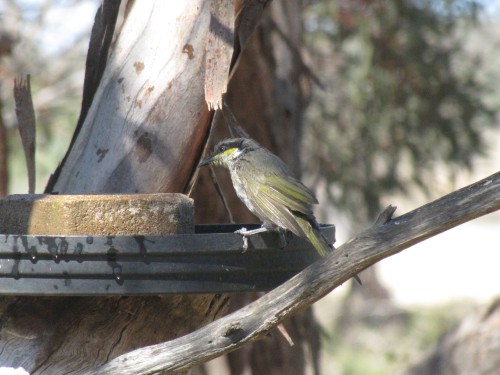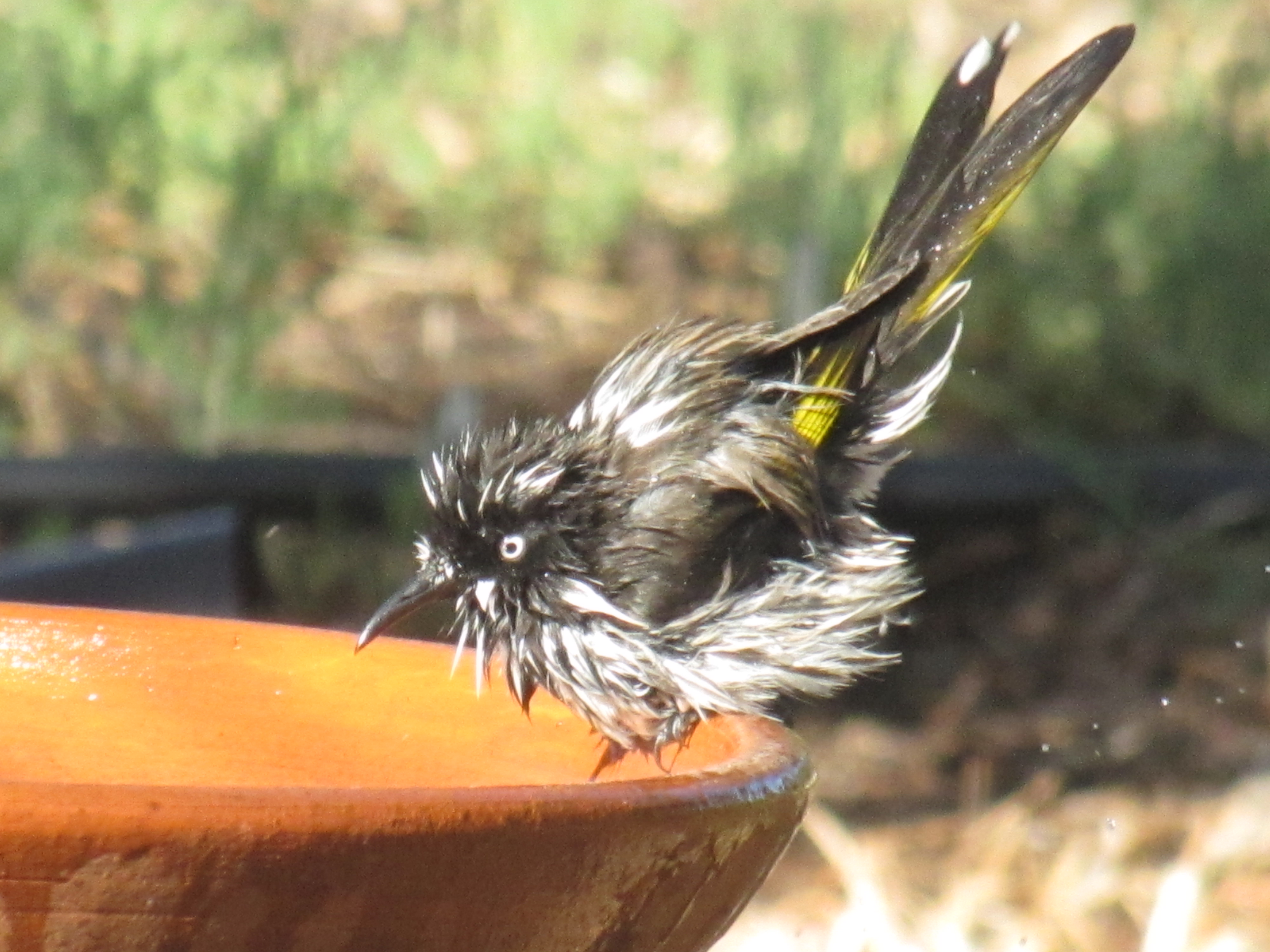Singing Honeyeater at the birdbath
Yesterday I wrote about New Holland Honeyeaters bathing in our bird bath (click here to view that post).
While the New Hollands are by far the most frequent and noisiest of the visitors to the bird bath, many other species also come to bathe or drink during our hot spells in summer. The New Holland Honeyeaters may come individually, but they are more prone to come in a flock of a dozen or more. The result is usually very noisy – and water sprays everywhere.
By way of contrast, the Singing Honeyeater shown in today’s photo quite often comes alone, or at most, two. They tend to be far more solitary birds in our garden. They often wait a short distance away while other species drink, then slip in quietly to drink when calmness returns.
Let’s all have a morning bath
Earlier this week it was rather warm. On most days we have some birds come to either have a bath, or have a drink. Many do both. Some just sit in the water, especially on very hot days.
On Tuesday of this week I was amazed at the procession of birds coming to drink and bathe. I was having my breakfast and it wasn’t yet very hot. This following is a list of species observed in a ten minute period:
New Holland Honeyeaters – about 12
White-plumed Honeyeaters – 2
Singing Honeyeaters – 2
Red Wattlebirds – 2
Crested Pigeon – 1
Spotted Turtledove – 1
Yellow Thornbill – 1
House sparrow – 10
Common Starling – 6
Australian Magpie Lark – 1
Superb fairy-wren – 3
Other species nearby:
Australian Magpie
White-browed Babblers
Willie Wagtail
The New Holland Honeyeaters caused the greatest kerfuffle; water went absolutely everywhere. I managed to capture this series of photos of one individual getting totally soaked.
Now I’ll have to get a bucket of rainwater and refill the bird bath.
Some of the photos shown here on Trevor’s Birding can now be purchased on tee shirts, coffee mugs, stationary and a large range of other items. Go to Trevor’s Photos site here.
Willie Wagtail up close
We have a resident breeding pair of Willie Wagtails in our garden. They are a constant delight as they flit around looking for insects to snap up for a tasty snack. They will often come quite close to us when we are working in the garden or sitting relaxing on the back veranda.
Due to higher than normal rainfall over the last nine months I’ve had to mow our grass quite a few times with our ride-on mower. As I move around mowing the Willie Wagtails follow the mower, snapping up insects disturbed by the machine. Sometimes I feared I’d actually drive over one of them because they were getting quite close.
The Willie Wagtails frequently come to our various bird baths for either a drink or to bathe. This always gives more opportunities to experience close encounters with this species. It also affords excellent opportunities for close up photography, such as the shot shown above.
Spiny-cheeked Honeyeater up close
The Spiny-cheeked Honeyeater is a resident breeding bird species in our garden. We see them every day as they go about feeding and especially enjoy their visits to our bird baths. The above photo was taken quite close to one of the bird baths. I also enjoy hearing their mournful call because it reminds me of my children. Both are now adults, but when they were quite young they renamed this bird the “yoo-hoo” bird, imitating its call. The name has stuck.
Spiny-cheeked Honeyeaters are found over large areas of Australia, primarily the drier inland woodlands and scrubs. It is absent from Tasmania, the northern tropical regions and the extreme south western and south eastern Australia.
Related articles and photos:
Let’s all have a bird shower
The birds in our garden really enjoy bathing in the bird baths we have provided. On warm days there is a constant stream of birds representing many species coming to drink and bathe. Sometimes it is not unusual to have 10 – 15 birds bathing, or waiting to bathe.
The New Holland Honeyeaters shown in this series of photos are perhaps the most demonstrative of all the species. They will often come in numbers, screeching out to family and friends to come and join them while the water goes in all directions. In fact, on hot days I need to replenish the water at least once a day, sometimes more.
In this series of photos I have captured more than just birds having a bath. The water sprays every where, creating a sort of ‘bird shower’ effect. The solitary Common Starling manages to keep its composure in the midst of all the chaos around him.
Click on any image to enlarge.









